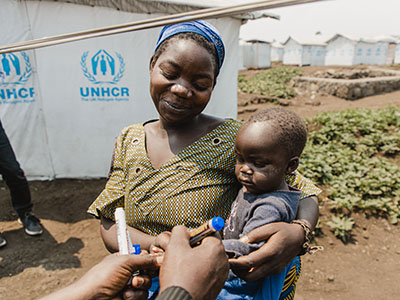Cover image: © UNICEF/UNI423796/Benekire
This course aims at increasing staff knowledge on the topic of human rights law and human rights mechanisms, including how they can be effectively used to promote the protection of asylum-seekers, refugees, stateless and internally displaced persons.
The Engaging with Human Rights Systems e-learning is aimed at increasing staff knowledge and competence on the topic of human rights law and human rights mechanisms, including how UN human rights mechanisms can be effectively used by UNHCR to promote the protection of asylum-seekers, refugees, stateless and internally displaced persons.
It can be taken as a standalone course, but also constitutes a mandatory module in the Human Rights Engagement in Practice Learning Programme (HREiP) and an elective module in the Certification Programme for International Protection (CP-IP), developed by the Global Learning and Development Centre (GLDC) in collaboration with the Division of International Protection (DIP).
- Integrate human rights and human rights concepts in your work;
- Identify opportunities and collaborate with human rights mechanisms;
- Incorporate engagement with the UN human rights mechanisms into protection, solutions and advocacy strategies.
Learning objectives
At the end of this course you will be able to:
- integrate human rights and human rights concepts in their work;
- identify opportunities and collaborate with human rights mechanisms;
- incorporate engagement with the UN human rights mechanisms into protection, solutions and advocacy strategies.
Audience
The course is recommended for all UN staff with protection and advocacy responsibilities.Length
It should take you about 180 minutes to complete this self-paced course.
Methodology
Interactive: Activities are spread throughout the three modules to strengthen your learning experience.
- Practice-oriented: You will also get many useful and practical tips on how you can build in human rights mechanisms into your work and where to find more examples and tools.
- Tests and certification: Each module ends with a brief question test that you will need to pass to progress through the course and get a final certificate at the end of the course.
Structure
This introductory course consists of 3 modules plus a short introduction with instructions.
Unit 1 provides an overview of what human rights are, and the various sources of human rights law. It explores international human rights law in particular.
Unit 2 focuses on the mechanisms of the universal human rights system, which is the system under the United Nations. This is not the only human rights system, though. Several organizations and treaties have been created at the regional level, and their obligations are monitored and implemented by a number of regional mechanisms.
Unit 3 concentrates on how to plan the use of UN human rights mechanisms for protection purposes, the procedures and processes through which UNHCR engages with the mechanisms, and some of the ways in which the outcomes of these processes can be used and followed up on.
Contact details
Content issues and questions:
UNHCR
HQDIPHGRL@unhcr.org
UNICEF
Regarding technical issues, please use the links listed at the bottom of the page under the Contact Us section.
